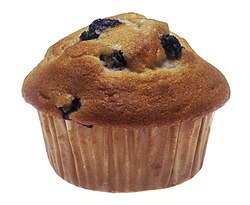
A muffin top (also muffin-top) is a slang term typically used to describe a person's body fat that extends horizontally over the edges of the waistline of tightly fitting pants or skirts, visible when there is a gap between the upper and lower garment. The term is a reference to the way a muffin appears when it has been baked in a muffin tin, so that the top of the muffin extends horizontally over and around the top of the tin or casing.
